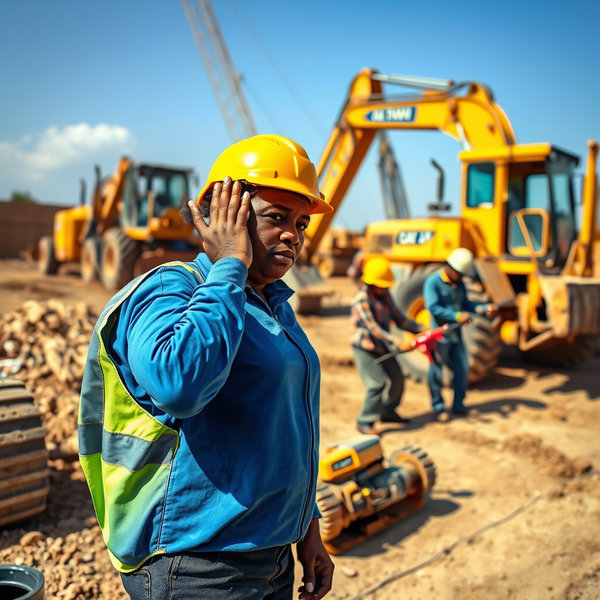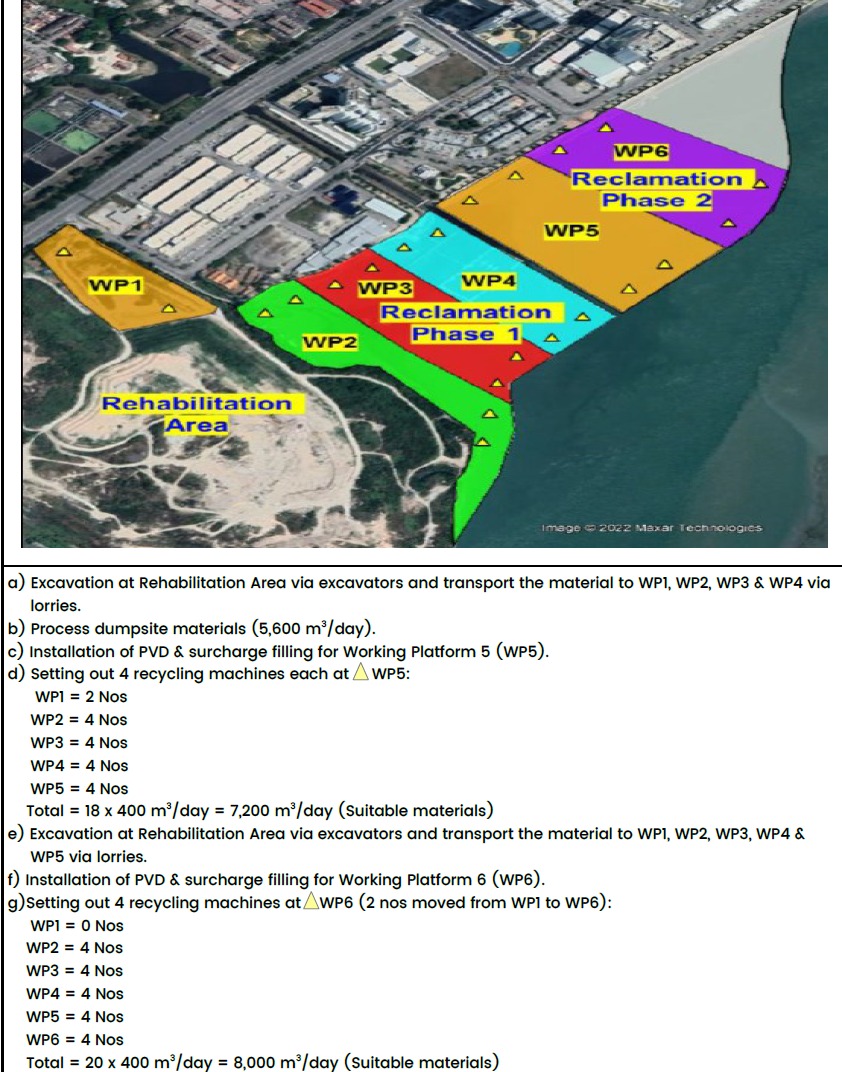
Noise Pollution Impact
The scientific facts about how the reclamation project will disrupt our peace and quality of life
Act Now
The scientific facts about how the reclamation project will disrupt our peace and quality of life
Act NowAccording to the PLB – EIA Report, the proposed reclamation project includes on-site recycling of waste materials excavated from the old landfill (Table 5.10). This recycling process, while intended to reduce external disposal and transportation, poses significant noise pollution for local communities. A maximum of 20 heavy-duty recycling machines (yellow triangles ⚠️ on the map below) will be deployed sequentially—from the landfill, through Fisherman’s Wharf, and reaching Nautilus Bay and Maritime — operating over 10 hours daily, in open-air conditions—drying, sorting,crushing, and processing, waste.

Source: PLB – EIA Report, Figure 5.27
The proposed reclamation project threatens to transform the peaceful atmosphere of Karpal Singh Drive into a cacophony of excavation, on-site recycling, reclamation, and construction noise that will last for at least 24 years (PLB – EIA Report, Page 5.16). This isn't just about minor inconvenience—it's about a fundamental degradation of our living environment and quality of life, backed by scientific data and acoustic modeling.
According to PLB's own Environmental Impact Assessment (EIA) Report(Table 7.67), construction noise is expected to far exceed acceptable levels set by the Department of Environment. The EIA's mathematical modeling (RCNM) predicts alarming noise levels:
EIA predicted level without control measures
(DOE limit: 65 dB(A))
EIA predicted level without control measures
(DOE limit: 65 dB(A))
EIA predicted level without control measures
(DOE limit: 65 dB(A))
These noise measurements were obtained using the RCNM (Roadway Construction Noise Model), the same professional modeling software used in environmental impact assessments worldwide. The data clearly shows that even with theoretical noise control measures in place, residents will still suffer significant noise pollution beyond acceptable thresholds.
To understand what these numbers mean for your daily life, consider these noise equivalents:
| Noise Level | Equivalent Sound | Impact on Health & Well-being |
|---|---|---|
| 40-50 dB(A) | Quiet office, library | Normal conversation possible, suitable for sleeping |
| 60-65 dB(A) | Normal conversation, air conditioner | Begins to interfere with sleep, affects concentration |
| 70-80 dB(A) | Vacuum cleaner, busy traffic | Causes stress, difficulty communicating, sleep disturbance |
| 80-90 dB(A) | Garbage disposal, lawn mower | Damage to hearing with prolonged exposure, significant stress |
| 90+ dB(A) | Motorcycle, construction equipment | WHO warns of severe health impacts including hearing damage |
⚠️ According to the EIA report, the predicted noise levels at Karpal Singh Drive will reach 85.3 dB(A)—equivalent to standing next to a food blender or lawn mower running continuously.
⚠️ The World Health Organization (WHO) recommends noise exposure limits of less than 75 dB(A) for 8-hour exposure to prevent hearing damage.
⚠️ WHO notes that 55 dB(A) or less is the desirable daytime outdoor noise level that won't cause annoyance.
⚠️ The project's noise levels will exceed both WHO recommendations and Malaysia's DOE guidelines for residential areas.
The Environmental Impact Assessment (EIA) report references Table 7.62 (sourced from the United States Environmental Protection Agency) to detail the noise levels measured at 15 meters from commonly used construction equipment. According to WHO, the ranges of noise levels are scientifically significant because sustained exposure above 80 dB(A) can adversely affect health. Below is a summary adapted directly from the EIA:
| Equipment | Noise Level at 15 m [dB(A)] |
|---|---|
| Loader (9100-200kW) | 83–92 |
| Cranes (Small Mobile) | 74–80 |
| Dump Trucks | 65–82 |
| Welding Sets (300 A) | 69–75 |
| Pile Driver (Air Hammer) | 80–101 |
| Chipping Hammer on Steel | 63–81 |
| Grinder | 63–68 |
| Air Compressor | 65–67 |
| Concrete Truck (24T) | 69–78 |
| Diesel Generating Sets (250 kVA) | 74–81 |
| Dowers | 85–87 |
| Jackhammer & Rock Drills | 82–98 |
| Saws | 74–82 |
As shown, certain pieces of equipment—especially pile drivers and jackhammers—can easily exceed 100 dB(A) at just 15 meters away, surpassing the recommended limits set by both Malaysia’s Department of Environment and the World Health Organization (WHO). Notably, many machines will operate simultaneously, the cumulative noise may exceed recommended environmental limits for residential areas.
8-hour exposures above 85 dB(A) can contribute to hearing damage, chronic stress, cardiovascular strain, and diminished quality of life. Considering the extended timeline of this proposed reclamation project—up to 24 years—residents would be subject to repeated high-decibel events with minimal respite.
According to the EIA report, construction activities will continue for years with:
This is not a temporary inconvenience—it represents a fundamental transformation of our community's soundscape for a generation.
The EIA document reveals a crucial but often overlooked aspect of construction noise—vehicle movements. According to the report:
"Exhaust noise from vehicles constitutes the predominant source for normal operation below 55 Km/hr... Diesel trucks are 8 to 10 dBA noisier than gasoline powered ones." (Page 7.239)
"According to the USA Environmental Protection Agency, sound pressure level projected from vehicular movements will fall within a range of 65 dB(A) measured 36 m away." (Page 7.239)
With hundreds of heavy construction vehicles moving materials daily, this constant traffic will create a persistent baseline of noise that exceeds residential standards.
The World Health Organization (WHO) has established clear links between noise exposure and health impacts. These noise levels will cause:
The WHO recommends "35 dB(A) or less (bedroom noise limit)" for "No likelihood of sleep disturbance." Even with perfect implementation of all mitigation measures, the projected levels of 41.5-52.3 dB(A) will make normal sleep patterns impossible for nearby residents, leading to chronic fatigue, decreased productivity, and serious health issues over time.
The EIA report acknowledges that "noise generated from construction activities is usually perceived by most residents as intrusive in nature." (Page 7.240). Scientific studies confirm persistent noise exposure above 65 dB(A) is linked to increased cortisol levels, irritability, poor concentration, and anxiety disorders.
According to WHO standards cited in the EIA report, "less than 45 dB(A) (background noise)" (Table 7.63) is required "For good speech intelligibility indoors." The projected noise levels will make normal conversation difficult, affecting everything from family discussions to work-from-home productivity.
Areas with high noise pollution typically see decreases in property values of 8-10%, according to international real estate studies. This represents a significant financial impact for homeowners who have invested in Karpal Singh Drive properties.
The EIA report makes bold claims about noise reduction measures (Table 7.68), stating they can achieve "noise reduction of 23-33 dBA" through various controls (Page 7.246). However, this is theoretical at best and misleading at worst:
1. These "controlled" levels assume perfect implementation of all mitigation measures—an unrealistic expectation given the project scale.
2. The report provides no enforcement mechanisms to ensure these control measures are implemented and maintained over the 24-year project timeline.
The EIA's proposed mitigation methods (Page 7.246) include:
One crucial scientific fact omitted from the Environmental Impact Assessment is the significant limitation of noise barriers for multi-story buildings. Academic research and acoustic science demonstrate that the effectiveness of noise barriers dramatically decreases for receivers located above the barrier height.
⚠️ Barrier panels alone cannot deliver the claimed 15-20 dBA reduction for noise originating above their crest.
⚠️ Residents on higher floors will likely experience noise levels close to the unmitigated values—well above health-based guidelines.
According to acoustic principles, sound waves behave differently than light—they bend around obstacles through a process called diffraction. This scientific phenomenon means:
Potential noise reduction from barriers
(Still inadequate)
Significantly reduced effectiveness
as height increases
Minimal to no protection
from noise barriers
These figures are derived from multiple peer-reviewed acoustic studies on noise barrier effectiveness in multi-story residential environments. The practical implication is clear: mitigation measures cited in the EIA are substantially overstated for the majority of residents living in apartments above the ground floor.
A fundamental acoustic principle is that noise barriers are most effective when they break the line-of-sight between the noise source and receiver. For elevated residences:
| Floor Level | Line-of-Sight to Construction | Expected Noise Exposure |
|---|---|---|
| Ground Floor | May be blocked by barriers | Reduced but still concerning levels |
| Middle Floors (3-5) | Partial direct line-of-sight | Approaching unmitigated levels |
| Upper Floors (6+) | Complete direct line-of-sight | Near-full unmitigated noise levels (70-85 dBA) |
This acoustic reality means residents in upper floors of properties like Mutiara Idaman, Summer Place, and other high-rise developments along Karpal Singh Drive will experience noise pollution at levels approaching the unmitigated predictions in the EIA—up to 85.3 dB(A) during active construction periods.
Studies in acoustical engineering have consistently demonstrated this principle:
Given the vertical distribution of residents in the affected area, the implications are severe:
📊 Approximately 65-75% of residents in the affected area live above the 3rd floor
📊 The vast majority of residents will therefore receive minimal protection from the proposed noise barriers
📊 Most residents will experience noise levels that exceed both Malaysian DOE guidelines and WHO recommendations for residential areas
This represents a significant oversight in the EIA's analysis and fundamentally undermines the claimed effectiveness of the proposed mitigation measures. The acoustic science clearly shows that multi-story residential communities cannot be adequately protected by ground-level noise barriers alone.
Based on established acoustic principles and peer-reviewed research, it is scientifically inaccurate to claim that proposed barrier solutions will reduce noise levels by 15-20 dBA for most residents in the affected area. The vertical distribution of residences means:
The scientific facts are clear: the proposed reclamation project will subject thousands of residents to harmful levels of noise pollution with no effective mitigation strategy for those living above the ground floor.
The EIA report itself provides the strongest evidence against the project. According to the noise modeling, even with theoretical controls in place:
"8 hour exposure above 90 dB(A) as shown in Table 7.63 can be detrimental to the residential communities nearby." (Page 7.240)
"Major excavation and construction in a normal suburban community will generate complaints if the eight hour Leq exceeds 85 dB(A) at the boundary line." (Page 7.240)
The project's own documentation confirms that residents will be subjected to noise levels that scientific research has definitively linked to health problems, cognitive impairment, and reduced quality of life.
Residents of Karpal Singh Drive and surrounding areas have a right to a peaceful living environment. The reclamation project, with its 24-year timeline of construction and development, represents an unprecedented threat to this fundamental right.
The scientific data is clear: this project will subject residents to noise pollution that exceeds both Malaysian environmental guidelines and international health standards. The impacts will be felt across all aspects of daily life—from sleep quality to mental health, from property values to overall community wellbeing.
The robust scientific evidence is clear: the reclamation project poses an unacceptable risk to our health. It is imperative that we demand a reject to this project.
We call on all community members, scientists, and concerned citizens to join forces and protest this environmental injustice.
History shows that organized, evidence-based protest can drive change. Together, we can compel decision-makers to prioritize public health over reckless development. Your voice matters—demand a sustainable future!
Join the Protest TodayThe evidence is clear. The noise from this project will exceed legal limits and impact our health for decades. Join us in opposing this harmful reclamation project and protecting our right to peace and quiet.
Sign the Petition